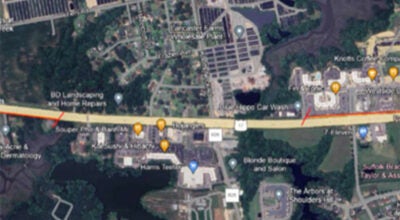SPS begins rezoning conversations in an effort to achieve unitary status
Published 4:53 pm Tuesday, March 19, 2024
|
Getting your Trinity Audio player ready...
|
Suffolk, Va. – During the monthly meeting of the Suffolk Public Schools board meeting, discussions began regarding the rezoning of seven elementary schools for the 2025-26 school year. The discussion comes as part of ongoing efforts to achieve unitary status and remain in compliance with desegregation requirements set forth by the United States Department of Justice.
School Board Attorney Wendell Waller, Chief of Schools Dr. Stenette Byrd, and Director of Technology John Littlefield presented what they called the first of many discussions on the topic. Waller says that the United States Supreme Court identifies six areas known as “green factors” to determine a school’s unitary status: student assignment/discipline, facility hiring, staff assignments, transportation, extracurricular activities, and facilities.
“The only area that remains unresolved before Suffolk Public Schools can achieve unitary status is student assignments,” Waller said. “The rezoning of the elementary schools will address this remaining area.”
Addressing the school community, SPS Superintendent Dr. John B. Gordon said this would be “a multiple-month process.” Gordon noted the importance of community outreach, including school-level town halls, for the rezoning.
“ … We’re going to ask our School Board members to be able to join any schools that are affected within your borough. These will be led by the principal as well central office staff to be able to support,” Gordon said. “That’s going to be our opportunity to collect information from our school communities as we’re going to ask for an adjustment to be made with school boundaries.”
Gordon emphasized the elementary school rezoning would not change the need for their capital improvement plan. Likewise, he asked for the school community to be “collegial and collaborative” regarding the rezoning process.
“Words matter when it comes to talking about individual students as well as neighborhoods. We are going to take all feedback into consideration. It is going to be the board’s decision based on recommendations that are coming from staff or any adjustments that they’re seeing. Every piece of feedback we get, we’re going to take a look,” Gordon said. “When we get further down this road, Mr. Littlefield and the team will have a list of the neighborhoods that will be affected to make sure that everyone has that knowledge when it comes to the discussion as well as making decisions.”
Byrd provided an overview of desegregation efforts and changes Suffolk underwent during the civil rights movement.
“Once upon a time, Suffolk was deeply entrenched in segregation practices, with separate facilities for African Americans and Whites, including schools. The landmark Supreme Court case, Brown v. Board of Education in 1954, declared segregation in public schools unconstitutional, setting the stage for desegregation efforts nationwide,” Byrd said. “While significant progress has been made, we still have schools with demographic representations that are not aligned with the demographic breakdown of our city. Through it all, our commitment to ensuring equitable education for all students remains steadfast.”
Byrd says that when rezoning, key considerations such as population distribution, education equity, capacity and utilization, impact on the community, and much more must be taken into account for an “equitable and effective process.”
Showcasing proposed rezoning maps and data, Littlefield detailed that seven elementary schools — Booker T. Washington, Elephant’s Fork, Hillpoint, Kilby Shores, Mack Benn, Nansemond Parkway and Southwestern Elementary Schools — will each be affected by the rezoning, while Northern Shores, Creekside, Florence Bowser or Oakland Elementary Schools will “not see any changes.”
On reaching this point, Waller discussed the historical context of the rezoning efforts starting with a lawsuit filed by the United States against Nansemond County School Board on May 27, 1970.
“The suit alleged that the school board maintained a dual system of public schools. At that time, there were eight schools traditionally maintained for white students and staffed by white teachers. There were 10 schools, traditionally maintained for black students and staffed by black teachers,” Waller said. “On Oct. 18, 1971, the federal district court entered an order approving the school board’s school desegregation plan. The school board’s plan addressed student assignment, faculty and staff assignment, transportation and other aspects of school operations.”
Waller says that on Dec. 8, 1971, the case was consolidated with the case of Walston v. Nansemond County School Board.
“Walston and several other named plaintiffs had filed suit alleging that the school board discriminated against teachers and principals in its hiring and employment practices on the basis of race,” Waller said. “After a successful appeal to the Fourth Circuit Court of Appeals, the court enjoined the school board from discriminating on the basis of race or color in the employment of teachers and other personnel and from making use of the NTE as an employment requirement without proper validation studies and job analysis.”
Wendell went on to say that on May 24, 1978, the court removed both cases with leave “for any party upon motion to have the case reinstated,” and with the order entered, there was no activity in either case. In 2009, however, the DOJ reviewed the school’s compliance with desegregation obligations and learned the school board had plans to construct Pioneer Elementary School — now known as Southwestern Elementary School.
“On Dec. 18, 2014. the Federal District Court granted a joint motion filed by the parties to reopen the school desegregation case and have the case reinstated to the court’s active docket,” Waller said. “In January 2014, the school board shared two proposed rezoning plans for the new elementary school. The DOJ could not agree to the rezoning plans because they failed to materially further desegregation.”
Due to this, the board agreed with the DOJ for the court to enter a consent order modifying the school board student assignment plan that would account for Southwestern Elementary School. This saw the plan introduce the Majority to Minority (M to M) Program in the 2014-2015 school year, allowing Black students attending schools with a Black majority to attend schools with a majority of white students and vice versa.
“For the 2014-15 school year, there were 78 students attending Southwestern under this M to M program. For this current school year, 24-25, there are 116 students attending Southwestern under the M to M program. This number has increased each year since the program’s inception, and it places an enormous burden on transportation and will eventually result in the overcrowding of Southwestern Elementary School,” Waller said. “The only viable option to addressing the racial disparity in certain schools is to consider rezoning at the elementary level.”
For more information on the M to M Program, go to https://www.spsk12.net/domain/68.







